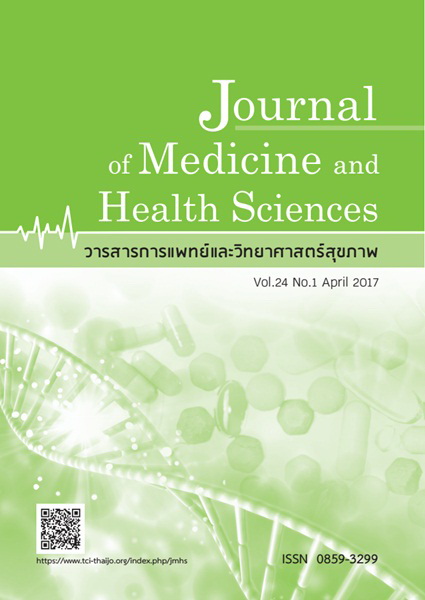ความชุกและปัจจัยที่เกี่ยวข้องกับภาวะเปราะบางของผู้สูงอายุในชุมชน: กรณีศึกษาในอำเภอเสริมงาม จังหวัดลำปาง/ Prevalence and associated factors of the frailty among community-dwelling elders in Sermngam district, Lampang province
Keywords:
ผู้สูงอายุภาวะเปราะบางการคัดกรอง/ Elderly Frailty Screening for frailtyAbstract
บทคัดย่อ
การวิจัยนี้เป็นการศึกษาแบบภาคตัดขวาง (Cross-sectional Study) มีวัตถุประสงค์เพื่อศึกษาความชุกและปัจจัยที่มีความสัมพันธ์กับภาวะเปราะบางของผู้สูงอายุที่อาศัยในชุมชนอำเภอเสริมงาม จังหวัดลำปางทำการสุ่มตัวอย่างแบบหลายขั้นตอน ได้กลุ่มตัวอย่างจำนวน 314 คนเครื่องมือที่ใช้ในการศึกษาครั้งนี้เป็นแบบสอบถามประกอบด้วย 3 ส่วน คือ ส่วนที่ 1ข้อมูลส่วนบุคคล ส่วนที่ 2ปัจจัยที่มีความสัมพันธ์กับภาวะเปราะบาง และส่วนที่ 3แบบประเมินภาวะเปราะบางในผู้สูงอายุ (FiND Questionnaire) แบบสอบถามนี้มีค่าดัชนีความตรงของเนื้อหา (CVI) เท่ากับ 0.8 และทดสอบความเชื่อมั่นของแบบสอบถามในส่วนที่ 3 ด้วยสูตรสัมประสิทธิ์สัมพันธ์อัลฟาของครอนบาค เท่ากับ 0.89 ทำการวิเคราะห์ข้อมูลหาความชุกของภาวะเปราะบาง โดยใช้สถิติพรรณนา และปัจจัยที่มีความสัมพันธ์กับภาวะเปราะบางใช้สถิติ Chi-square และ Fisher’s Exact test ผลการวิจัยพบว่าความชุกของภาวะเปราะบางเป็นร้อยละ26.4 โดยพบสัดส่วนในเพศชายมากกว่าเพศหญิง (ร้อยละ 30.4 และ 23.3) ช่วงอายุที่พบภาวะเปราะบางมากที่สุดคือ อายุ 60-69 ปี พบในเพศชายมากกว่าเพศหญิง (ร้อยละ 31.9 และ 27.8) ความบกพร่องทางการเคลื่อนไหวเป็นร้อยละ 30.3 โดยพบสัดส่วนในเพศหญิงมากกว่าเพศชาย (ร้อยละ 33.0 และ 26.8) ช่วงอายุที่พบความบกพร่องทางการเคลื่อนไหวมากที่สุดคือ อายุ 80 ปีขึ้นไป พบในเพศหญิงมากกว่าเพศชาย (ร้อยละ 47.4 และ 37.5) และปัจจัยที่มีความสัมพันธ์กับภาวะเปราะบางอย่างมีนัยสำคัญทางสถิติที่ระดับ 0.05 คือ ปัจจัยส่วนบุคคล ได้แก่ ระดับการศึกษา ปัจจัยด้านกายภาพ ได้แก่ ภาวะสุขภาพในช่วง 1 เดือนที่ผ่านมา ภาวะสุขภาพปัจจุบันเมื่อเปรียบเทียบกับอดีต การเจ็บป่วยด้วยโรคเรื้อรัง และปัจจัยด้านจิตใจและการรับรู้ ได้แก่ ภาวะสมองเสื่อมในผู้สูงอายุที่สำเร็จการศึกษาระดับประถมศึกษา
Abstract
This research was a cross-sectional study. That aimed to investigate the prevalence and factors associated with the frailty of Ccommunity-dwelling elders in the Sermngam district of the Lampang province. The study used a multi-stage sampling. The sample consisted of 314 lders. The instrument used in this study was a questionnaire consisting of 3parts, the first part was concerned with personal information; the second part was about the factors related to frailty; and the third part was older frailty assessments (FiND Questionnaire). This content validity index (CVI)of this question are was 0.8 and the correlation coefficient Cronbach’s alpha of Part 3 was 0.89. The prevalence of frailty and factors associated with frailty analyzed by descriptive statistics analyzed by Chi-square Fisher's Exact test The research found that The prevalence of frailty was 26.4 percent and the proportion of frailty in males more than females (5121and 23.3percent).Age range with frailty found the highest group in aged 60-69 years and found in males more than females (31.9 and 27.8percent).The prevalence of disability was 30.3percent, the proportion of disability was higher in females than males (33.35%and 26.8%). The age range with the higest rate of disability in aged over 80years and found in females more than males (47.4%and 37.5%) factors associated with frailty were statistically significant at level of 0.05 were personal factors such as level of education, physical factors such as their level at health over the past one month compared to their current health status, chronic diseases, and psychological factors and perceptions, including dementia in older adults who have completed primary education.



